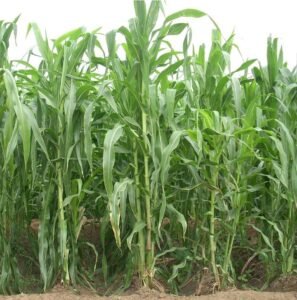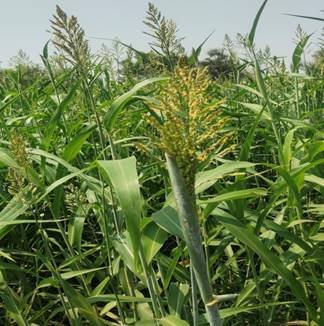CULTIVATION PRACTICES OF NON-LEGUMINOUS ANNUAL FODDER
MAIZE OR CORN
Maize is not found in wild state. Origin appears to be Mexico. For long time it is exclusively grown for grain but in the last 90-100 years it is also grown for forage. Grain is an important ingredient for poultry feed. Mostly dent types (angular grain concave on the top) are grown for forage. The male inflorescence is called TASSEL and female as COB. It required 600-900 mm rainfall in the growing season. It is grown on a variety of soils, but well drained fertile soils are best suited.
Maize is mostly grown as Kharif crop i.e., sowing in June-July. In South India it makes best growth in Rabi and also in Summer. It can be grown throughout the year.
Varieties
All varieties (composites, synthetics and hybrids) developed for grain production can also be used for fodder production. Usually tall varieties are preferred for fodder.
African tall, J-1006, Vijaya composite, Ganga-5, are some important fodder varieties. APFM – 8, 12 and 22 are developed at ANGRAU.
Thorough land preparation is required. Land can be made into flat beds or ridges and furrows Seed rate and spacing for fodder crop are 50-60 kg/ha & 30 x 10 cm. In case if it is grown for grain, seed rate and spacing for grain crop are 15 kg/ha & 60 x 20 cm.

Maize responds very well to fertilizer nitrogen. Fertilizer dose can be 120:60:40 of NPK (kg/ha). K is applied for balancing the crop nutrition. N is applied in two equal splits i.e., half as basal (before sowing) and half at knee high stage(35 days after sowing).
Maize is sensitive to stagnant (water logged) conditions in the initial stages and sensitive to moisture stress from knee high stage onwards. Hence, the crop should be free from water logging in the seedling stage and later should be given adequate irrigations. During rabi and summer, irrigations can be given at 7-10 days interval. Maize responds very well to irrigation.
The fields should be kept weed free at least up to knee high stage. Two inter cultivations coupled with hand weeding at 20 and 40 days after sowing will be effective. Chemically weeds can be controlled by pre emergence application of atrazine @1.0 kg a.i/ha. For green fodder, maize is harvested from tasselling stage onwards and up to milk stage of grain maturity.
Maize does not contain any harmful chemical and it can be fed to animals at any of its growth stages. In India it is used as green fodder and also as stover (by-product from grain crop). In western countries, it is mainly used for silage making.
We can get only single cut from maize. The average green fodder yield will be 40-50 t/ha and the dry matter yield will be 10-15 t/ha. Staggered sowing should be practiced for long period supply of green fodder. Maize can be intercropped with legumes like cowpea or lab-lab. Usually 2:2 ratio is adopted.
SORGHUM or JOWAR or GREAT MILLET
Sorghum is believed to be indigenous to Africa, although India and China are claimed to be the home of certain varieties of sorghum. It is cultivated mainly for grain and also for fodder. In USA, certain types with sweet and juicy pith are grown for manufacturing syrup. These syrup types are also used as forage sorghums, in preference to those with dry pith.
Sorghum is a drought resistant crop. It thrives in tropical climate with a temperature range of 25-350C. It is not suited to higher elevations (more than 1200m). It can be grown under an annual rainfall of 300-350 mm. It can be grown on any soil except on very sandy soils. Sorghum is a short day plant and 10 hours photoperiod results in earliest flowering. It is mostly grown in kharif season as rainfed crop and during summer under irrigation. There is a special season called Maghi for sorghum in parts of Andhra Pradesh. It is less suitable for Rabi season.

Varieties
All the grain types and hybrids can as well be grown for fodder purpose. Usually varieties with thin stem and more leafy nature are used for cultivation as fodder.
Some of the common fodder varieties are P.C-6, P.C.-23, M.P. chari, U.P.chari -1, and 2, CSV- 30F, Madikattu Jonna. APFS-3 and 5 are developed by ANGRAU. All these varieties are single cut types. Some Multicut Hybrids are CSH24MF, CSH20MF
SSG 59-3 is developed by crossing sudan grass (Sorghum sudanense) with sorghum. It is called as sweet sudan grass. It is a multicut variety. Derivatives of such inter specific hybrids combine the desirable features of both sorghum and sudan grass such as low HCN content, quick growth, better regeneration capacity, apart from high yield potential. There are some multicut hybrids such as Hara Sona, X-988, Safed Moti, Jumbo, MFSH-8, CoFS 29, 32etc which are produced and marketed by private organization. Some varieties of sorghum are developed for dual purpose i.e., for both grain and fodder, and are tall in nature. PSV-56 and APDS-1 is an example for dual purpose sorghum. Perennial fodder sorghum varieties are COFS 29 and COFS 31 released from TNAU (Coimbatore)
Thorough land preparation is required for this crop. The seed rate is 20- 25 kg/ha for bold grain types and 10 kg/ha for SSG 59-3. The recommended spacing is 30 x 10 cm and the depth of sowing is 2-5 cm. The recommended dose of NPK fertilizers is 80:40:40 kg/ha. Entire dose of P and K is applied as basal i.e., at the time of sowing and N is applied in two equal splits, half as basal and half at 30 days. For multicut varieties 30 kg N/ha should be applied after each cut. As sorghum is drought resistant, it can be irrigated once in 8-12 days during summer depending upon soil type.
The crop should be kept weed free for the first 30-40 days. Atrazine@0.5-0.75 kg a.i /ha as pre- emergence herbicide applied 2-3 days after sowing can effectively control most weeds of sorghum fields. Striga, a partial root parasite is a problem in some areas. Striga asiatica and Striga hermonthica are the most important and wide spread species. Striga can be controlled to some extent by crop rotation or by using trap crops and also by spraying 2, 4-D.
Sorghum plants contain HCN in the form of Dhurrin ( a Precursor for HCN) particularly in the early stages. It is dangerous to animals when it exceeds 750 ppm. Usually hay & silage are free from HCN and SSG 59-3 is also free from HCN. Sorghum can be harvested after flowering stage for green fodder. Average yield of green fodder is 35-40 t/ha for single cut types. For multicut varieties it is about 100 t/ha in 3-4 cuts. Finely chaffed sorghum stover, popularly called as KUTTI is widely used by the dairy farmers in and around Hyderabad. Sorghum is used as green fodder and is also conserved as hay and silage.
BAJRA or PEARL MILLET
Distributed in Africa, Southern Europe, USA, Australia and Indian sub continent. The plant is erect, annual culms are one to many, robust often 1.8-2.4m tall. Inflorescenee is panicle, stiff spike like and very dense varying in length from 10 cm to 91 cm.
It is an outstanding summer growing fodder crop for the dry farming areas because of its drought and heat tolerance and it can adapt to wide range of soil and climatic conditions.
It is a short day species. Black soil, clay and red chalk soils are suited. Cultivation with a country plough to prepare the tilth and to support the weeds is sufficient
Varieties
Moti Bajra, Giant bajra , APFB-2, Rajco, BJ 104,530, HB 3,4,5 are grain hybrids suitable for fodder production.
Can be sown at any time of the year in all seasons, if irrigation is available. Sowing can be done by broadcasting or dribbling in rows or furrows. Seed rate of 6-20 kg/ha with row spacing of 25-30 cm apart is ideal. For broad casting method, the seed rate will be double that of row sowing. NPK requirement is 54-96:36:27 kg/ ha. FYM of 20 t/ha is to be applied. Irrigation to the young plants during fast active growth phase is necessary because the seedlings are highly sensitive for dry spells.
Pre-emergence treatment with atrazine@0.5 kg ai /ha or 1 kg of 2,4-D/ha about 5-6 wks after sowing should be done to remove the weeds at the initial stages of crop growth.
Harvesting can be done at 50% flowering stage. The yield of green fodder is 20-40 t/ha. Legumes like cow pea, green gram, black gram, horse gram can be used as crop mixtures.
OATS
It is native of Europe and distributed in Asia, USA, USSR, Canada, Poland, France, Germany, UK. In India oats are grown in northern parts as rabi crop.The fodder oats may be erect or spreading annuals. The leaves are about 25 cm long and 1-5 cm wide. The grains are long, hairy at the apex. It as an ideal fodder as a green chop, silage and hay mostly covering the lean periods of the year. Commonly grown as a winter crop in the temperate areas. Grows well in all types of soils. Requires well prepared and firm seed beds. Two ploughings followed by two harrowings are sufficient.
Varieties
variety, UPU – 212, Weston II, FSO29, Flamings gold, OS–6, Algerian, EC – 1185. IC- 4263, Radar etc.
Seed rate is 75-80 kg /ha for small seed varieties and 100-125 kg/ha for bold seed varieties. Transplantation of 4 weeks old seedlings can be practiced with a row spacing of 25-30 cm. FYM requirement is of 25 t/ha. The requirement of NPK is 32:16:12 kg/ha. One pre-sowing irrigation is required. Subsequent irrigations can be provided for every four weeks interval. 2, 4-D @1.5kg a i/ha is to applied as weedicide at 2-3 wks after sowing. Harvesting is done at pre-flowering or 50% bloom stage. Yield of green fodder is 35-45t/ha.
